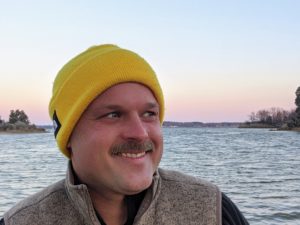100 Shirts, 100 Shores

By Molly Weeks Crumbley
One Chesapeake Bay—many stories. That’s the concept that artist Eric Jackson explores in his 100 Shirts, 100 Shores project. Using water samples from 100 different locations along the Chesapeake Bay, Jackson will use a traditional batik process to create 100 unique shirts that tell a collective story about conservation, history, and connection.
 Jackson, of Bay Fiber Studios in Leonardtown, uses a wax and dye-based resist process in his artwork that “creates a unique aesthetic in each piece that feels contemporary, but still familiar.”
Jackson, of Bay Fiber Studios in Leonardtown, uses a wax and dye-based resist process in his artwork that “creates a unique aesthetic in each piece that feels contemporary, but still familiar.”
In 2015, he got the idea to incorporate water from fishing locations into painted images of the fish themselves. This latest project grew out of that concept, but on a larger scale.
Before turning to the arts, Jackson originally planned to study biology and has memories of environmental summer camps and field studies with the Chesapeake Bay Foundation. “A connection to the water has always inspired me to get out there, and also come back and create, based on my experiences on the bay,” Jackson says. “I’ve also fished a lot of the western part of the middle bay for 30 years now, and I think there’s this innate curiosity to explore new locations which comes with recreational fishing. There’s that theme of discovery and journeying that is important to the project.”
The 100 Shores project quickly struck a nerve in the community; the initial Kickstarter campaign was fully funded in less than 12 hours.
A lot of people in Chesapeake Country have stories to share. Jackson recounts, “almost immediately, I started getting stories and tidbits from supporters who had their own connections to places on the watershed they wanted to share with me. It became clear very quickly that the stories themselves were equally important to the project as the shirts or the actual shores. It’s continuing to evolve as more and more people catch wind of what’s happening.”
As such, Jackson is collaboratively choosing his 100 Shores, taking in all of the suggestions and making a plan that accounts for historical significance, biodiversity, and personal connections. The majority of his planned sample sites fall along the main stem and major tributaries of the Chesapeake.
As with all of his work, a portion of proceeds will be donated to organizations whose work benefits the Chesapeake Bay watershed.
Jackson hopes that his project can help bring attention to the environmental issues befalling the Bay. “I’ve considered myself an advocate and conservationist for a long time, and I’ve seen how organizations have effectively driven change over the years through data-driven programs, infrastructure and policy. I have always wondered if there’s an opportunity to also drive change through eliciting an emotional response based on a more expressive experience that you give to an audience. I’d like to add to that conversation by creating work that is for the Bay, and not just about the Bay.”
Follow Jackson’s project at onehundredshores.com, and on Instagram @bayfibers.
